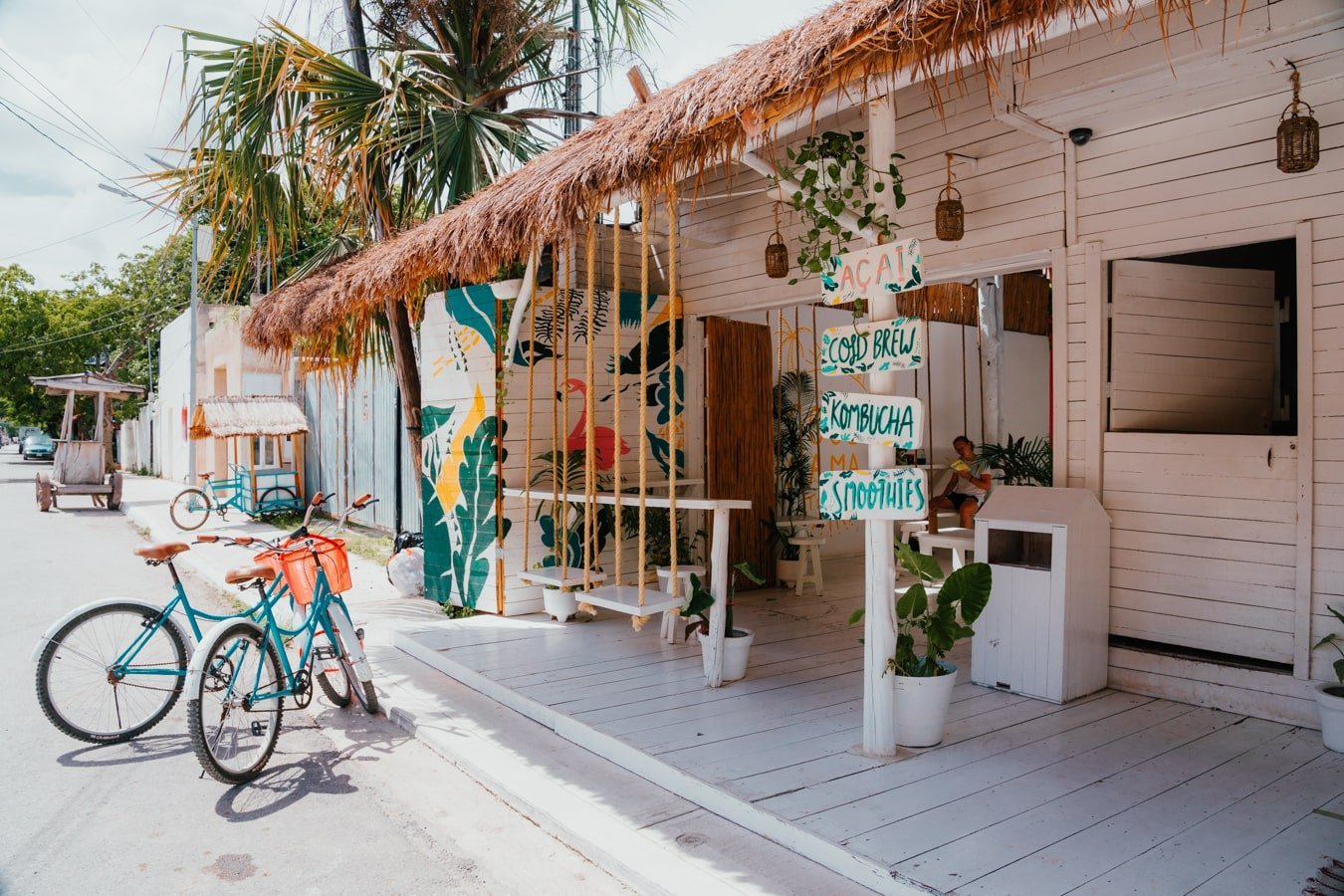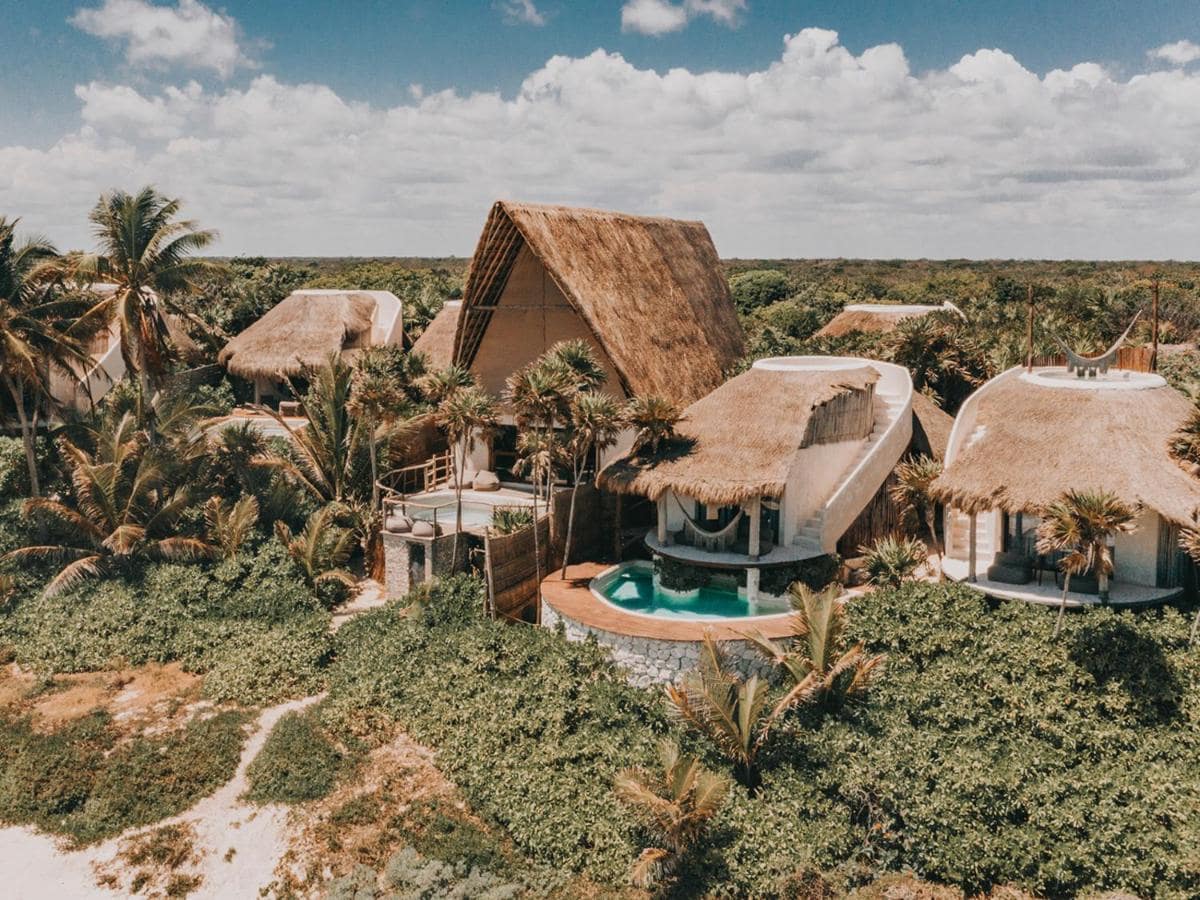The Ultimate Tulum Travel Guide: What You Need to Know
Disclosure: This blog is reader-supported, and some posts contain affiliate links. If you make a booking, I may earn a small commission—at no extra cost to you. Thank you for keeping me writing and doing what I love!
Between the Tulum ruins, general boho vibes, and incredible Tulum cenotes, it’s no wonder that Tulum is facing massive overtourism.
It’s paradise!
Or is it?

Having lived in Tulum as a digital nomad, I’ve had more time to explore a different side of this coveted destination; a side that’s more sustainable and gives back to the local community instead of taking away.
While Tulum is not always a picture-perfect paradise, I’ve discovered some of my favorite things to do, where to stay, eat, play, and more, and wanted to share this brief overview with you!
From scouting out the best cenotes around Tulum to finding the best places to eat and activities to do, to finally exploring the Tulum ruins and secret beaches (and not so secret)…
Here’s my guide to the “best of” Tulum and how to visit this once-underrated pueblo responsibly.
The Ultimate Tulum, Mexico Travel Guide

Getting to Tulum
The ride from Cancun Airport to Tulum is easy. You can either rent a private taxi or rent a car for as little as $25-40 USD per day. (Save when you book with Discover Cars!)
There are also public options like the ADO bus or a shared colectivo (mini van), or you can make things extra easy by booking a transfer shuttle one-way from the Cancun Airport.
There is a lot to love/hate about Tulum.
First, when you visit, the layout of Tulum can be a bit confusing. Tulum is essentially very spread out and divided up into 2-3 main areas.
You have the Tulum Pueblo (Town), Aldea Zama (ex-pat/condo neighborhood in development), and the Hotel Zone which runs parallel to the coast (there’s also the up-and-coming La Veleta ex-pat neighborhood).
If you don’t have a rental car, I’d recommend renting a scooter in Tulum for 1-2 days to easily get to/from the beach and hotel zone and the nearby cenotes.
Understanding Tulum’s Neighborhoods

The Zona Hotelera is probably what you think about when you think/see pictures of Tulum.
Boho-chic shops, gastronomic restaurants, popular Instagram photo spots, luxurious “eco” hotels, and private beach clubs.
It takes at least 45 minutes on the bike to see the length of the Hotel Zone and get to the more popular places like the amazing art statue “Ven a la Luz” or the swing bar at Matcha Mama.
The road you take in is the road you take out, and it’s super crowded with trucks, cars, and it’s just not fun. Parking is a nightmare. That said, people tend to overidealize this area of Tulum.
In truth, there’s a lot of greenwashing — aka smearing “eco-friendly and sustainable” — all over the place. (More on this later.)

Tulum Pueblo is the town where you’ll find both local gems and more touristy spots. This is the area where we live and we honestly love it the most.
It’s where you’ll get to witness Mexican culture. Eating out and shopping are generally cheaper here, too.
Being in town also gets you closer to all the cenotes around Tulum, which are just east, north, and west of Tulum’s Pueblo.
There are many cenotes along the Coba road (on the way to Coba ruins) to check out.
You can also discover Tulum’s growing street art scene in the town’s back streets.

Aldea Zama is an upscale neighborhood in development.
It’s in between Tulum Town and the Hotel Zone. There’s not much to see here, just yet, unless you are searching to buy a condo or rent out an apartment. The neighborhood is quiet and so many ex-pats choose to live here.
You wouldn’t just wander in here as a tourist because, for now, there’s not that much to do.
La Veleta is a livelier, more upbeat neighborhood in the southwest part of Tulum Town. It’s one of the most sought-after places to live since it offers both convenience (closer to the town) and quiet (close to the jungle).

Where to Stay in Tulum for First-Timers
As for where to stay, this is tricky. Tulum has some of the most incredible hotels. Places that are just jaw-dropping. But they often come at an environmental cost.
The below list is just a few of the most eco-friendly hotels and accommodations in Tulum.
They are not going to save the world or solve Tulum’s eco-crisis, but I would feel comfortable staying in these resorts as someone who endeavors to travel responsibly.
Habitas: Habitas is one of the best places to stay in Tulum whether you care about sustainability or not.
Here, between the sea and the jungle, lies a “sustainable sanctuary” filled with incense-lined, sandy pathways and luxury hammocks swaying between palms with their gastronomic restaurant, Moro, as its centerpiece.
We had dinner here one evening and it was an awesome experience.

Ahau: Another option for eco-friendlier accommodation (and beach club) is Ahau. This hotel is located behind the lady goddess/art structure in the Hotel Zone.
Ahau uses composting toilets, biodegradable bags/cups/straws; catches and recycles rainwater; purifies its wastewater and recycles for the garden; provides natural/eco toiletries, and more.
They often do beach clean-ups and their construction was built without disturbing the natural jungle.

Papaya Playa Project: Papaya Playa is a whole vibe on its own. Its reputation as an award-winning hotel precedes itself as one of the most popular hotels in all of Tulum.
They use retreated wastewater which irrigates the plants and garden; their food is also locally grown and organic when possible, they use solar energy made in Mexico, and they were able to retain 93% of the jungle when constructing (compared to the 5% average).
The Truth About Tulum’s Cenotes

You may have been catching my drift throughout this guide, but Tulum has more than a few glaring environmental issues.
While some local businesses are trying their best to help, Tulum is often an example of how overtourism and poor infrastructure can negatively impact a destination.
Throughout the years, these problems have spread to affect Tulum’s beloved cenotes.
As tourism boomed and the influx of visitors increased, shoddy construction jobs, poorly built waste management systems, and the removal of mangrove forests all began to cause sewage to run into the underground aquifers in Tulum. The same natural waterways that lead to the cenotes.
Several studies and water tests have shown everything from fecal matter to E. coli and cocaine as contaminants in the cenotes. Not only could this cause potential health problems for anyone planning to swim in these stunning swimming holes but also for local wildlife.
Some ways you can help are by staying at truly environmentally-friendly properties in Tulum with eco-conscious sewage systems (e.g. composting toilets) and by being sure to shower before entering the cenotes yourself, as well as practicing Leave No Trace.
Sadly, the pollution of the cenotes is just the tip of the iceberg when it comes to the environmental impact that the rapid increase in tourism has had on Tulum.
The Dark Side of Tulum Documentary
When you get the chance, watch The Dark Side of Tulum (Documentary). It reveals the sad and rapid demise of Tulum that many people don’t know about. It is appropriately called The Dark Side of Tulum.
It is a must-watch for everyone planning to visit Tulum now or in the future. Share it with your friends, too!
Tulum has exponentially grown over the past decade. As a result, the town has become saturated with tourists even during the off-season.
The town’s infrastructure wasn’t meant to maintain the number of people visiting Tulum every year.
And in fact, the beloved “eco-friendly resorts” for which Tulum has become famous aren’t all that eco-friendly or sustainable.

Most of the so-called eco-friendly resorts that line the Tulum beach run completely off diesel generators. And most of the waste is mismanaged and left to drain into the underground river.
Yep, the cenotes — another reason why Tulum has become such a popular destination — are being polluted by thousands of tons of literal sh*t.
If you stay along the Hotel Zone, you’re more than likely contributing to this mismanagement of waste. I know it’s not 100% avoidable. 😢
But there are hotels doing better and are trying to implement eco-friendly practices when and where they can. When you come to stay in Tulum, at least take this into consideration.
When you can, support businesses and hotels that are doing the opposite of greenwashing and are actually trying to make a difference.
Also Read:
- 9 Ways to Promote Sustainable Tourism for a Greener Future
- 25 Eco-Friendly Travel Tips for the Sustainable Traveler
- Ethical Tourism: What Does It Mean? Plus, 23 Tips to Travel More Ethically
The Best Places to Eat in Tulum


You can find every type of food here and during our time there, we found the best restaurants in Tulum.
The most popular areas to eat are found in both Tulum Town and the Zona Hotelera – choose from dozens of vegan and vegetarian options, from earthy cafes and hipster bars, and of course, local authentic Mexican restaurants!
🌿 La Hoja Verde: La Hoja Verde is a vegan-vegetarian gem right in the heart of town. Their barbecue soy-based tacos are SO good and so are their bowls, salads, juices, and mezcal cocktails.
🍔 Bonita: For burgers (beef, chicken, vegan) plated with a side of garlic, parmesan, or habanero fries, head to Bonita. Go for dinner when their cute outdoor patio and centerpiece tree are strung with evening lights.
🌱 Botanica: Botanica knocks Tulum’s boho-chic decor out of the park. This is one of our favorite places to eat here with delicious brunch-style toasts (with homemade bread), quiche, and fresh juices and treats. Their food and ambiance are just perfect.
🌮 El Bajon Vegan Tacos: This hole-in-the-wall is an awesome spot to dig into vegan tacos and one of the first local gems we discovered when we moved to Tulum. Cheap at $25 pesos/taco and oh so good. Right next to a vegan market too!

☕️ Ki’bok Coffee: A Tulum “staple” for where to eat. Their breakfast/lunch is always spot-on. But they’re extremely popular and sadly have become somewhat victim of their own success.
🍓 Matcha Mama: That famous Instagram swing bar? That’s Matcha Mama. You can slurp down acai bowls and green smoothies here. There are now four different locations around Tulum – Zona Hotelera, Aldea Zama, Pueblo, and a bit further down the beach in Ikal.
🥑 Raw Love: Another famous place to eat with 100% plant-based items. I freaking love their avo toast with purple sauerkraut. They also have two locations (town + hotel zone behind the amazing lady art piece).
🌯 Burrito Amor: Burritos are served in banana leaves and a cute indoor/outdoor tropical ambiance. Definitely recommend it for lunch on a beautiful day in town.
Best of Tulum Activities
There are so many things to do in Tulum!

Here are just a few of my favorite activities that I’ll do each time I visit Tulum:
- Scuba diving in cenotes + Tulum reef
- Wandering the Tulum Mayan ruins
- Visiting Coba ruins and Coba cenotes
- Floating down Mayan trade routes in Sian Ka’an
- Biking in Tulum (Town + Hotel Zone)
- Lounging on Playa Paraiso (free beach)
- Going to the night street food market
- Seeking out all of Tulum’s street art
If you don’t want to explore Tulum on your own, go with a guide! Here are a handful of recommended Tulum tours on GetYourGuide.
More Things to Do & Places to Go Near Tulum

If you’re based in Tulum you will quickly find out that there are plenty of day trips you can do.
As I mentioned above, the most popular quick and easy day trips from Tulum are definitely to Coba Ruins and the Sian Ka’an Biosphere Reserve where you can float down an old Mayan trading route.

But it’s also possible to drive to Playa del Carmen and even Cancun.
There are islands nearby like Isla Mujeres or even Cozumel that you can visit in a day if you leave early enough. But don’t stretch yourself out too thin.
These places deserve at least a full day or two to explore and discover so the best is to hang around the 1-2 hour range around Tulum.
On the other hand, many vacationers who stay in Tulum take a trip to Valladolid to see nearby Chichen Itza.
There are plenty of tour buses that run early in the morning so you can get there and even be back later in the evening.
But again, these sites merit at least a full day or more so you don’t feel rushed to see all the sights!
Final Thoughts: Best of Tulum Mexico
Tulum is an example of both raw natural beauty and human greed.
On the one hand, its gorgeous cenotes, beaches, people, and culture inspire travelers around the world to visit and share in the learning of the Mayan culture and natural beauty Tulum offers. 🤩
On the other hand, Tulum is being destroyed by irresponsible, unsustainable business owners and mismanagement of hotels through flawed waste removal and lackluster energy grids. 😔

The surplus of people and rapid influx of tourism has further aggravated the problem of both pollution and litter, which seep into the ground and contaminate the pure water flowing beneath your feet. The same water that flows both to the ocean and the beautiful cenotes…
If you do visit Tulum because it’s on your bucket list, make sure to travel with purpose and be conscious of your impact on the local environment.
We must promise to be more conscious travelers and leave Tulum better than how we found it! You can read even more essential travel tips for Tulum here. ✨